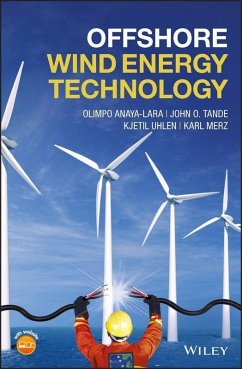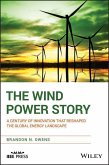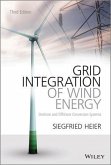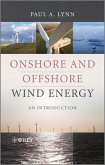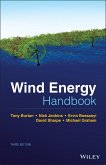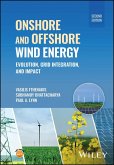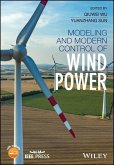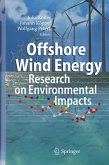Offshore Wind Energy Technology (eBook, PDF)


Alle Infos zum eBook verschenken

Offshore Wind Energy Technology (eBook, PDF)
- Format: PDF
- Merkliste
- Auf die Merkliste
- Bewerten Bewerten
- Teilen
- Produkt teilen
- Produkterinnerung
- Produkterinnerung

Hier können Sie sich einloggen

Bitte loggen Sie sich zunächst in Ihr Kundenkonto ein oder registrieren Sie sich bei bücher.de, um das eBook-Abo tolino select nutzen zu können.
A COMPREHENSIVE REFERENCE TO THE MOST RECENT ADVANCEMENTS IN OFFSHORE WIND TECHNOLOGY Offshore Wind Energy Technology offers a reference based on the research material developed by the acclaimed Norwegian Research Centre for Offshore Wind Technology (NOWITECH) and material developed by the expert authors over the last 20 years. This comprehensive text covers critical topics such as wind energy conversion systems technology, control systems, grid connection and system integration, and novel structures including bottom-fixed and floating. The text also reviews the most current operation and…mehr
- Geräte: PC
- mit Kopierschutz
- eBook Hilfe
- Größe: 20.03MB
![The Wind Power Story (eBook, PDF) The Wind Power Story (eBook, PDF)]() Brandon N. OwensThe Wind Power Story (eBook, PDF)65,99 €
Brandon N. OwensThe Wind Power Story (eBook, PDF)65,99 €![Grid Integration of Wind Energy (eBook, PDF) Grid Integration of Wind Energy (eBook, PDF)]() Siegfried HeierGrid Integration of Wind Energy (eBook, PDF)94,99 €
Siegfried HeierGrid Integration of Wind Energy (eBook, PDF)94,99 €![Onshore and Offshore Wind Energy (eBook, PDF) Onshore and Offshore Wind Energy (eBook, PDF)]() Paul A. LynnOnshore and Offshore Wind Energy (eBook, PDF)64,99 €
Paul A. LynnOnshore and Offshore Wind Energy (eBook, PDF)64,99 €![Wind Energy Handbook (eBook, PDF) Wind Energy Handbook (eBook, PDF)]() Tony L. BurtonWind Energy Handbook (eBook, PDF)110,99 €
Tony L. BurtonWind Energy Handbook (eBook, PDF)110,99 €![Onshore and Offshore Wind Energy (eBook, PDF) Onshore and Offshore Wind Energy (eBook, PDF)]() Vasilis M. FthenakisOnshore and Offshore Wind Energy (eBook, PDF)113,99 €
Vasilis M. FthenakisOnshore and Offshore Wind Energy (eBook, PDF)113,99 €![Modeling and Modern Control of Wind Power (eBook, PDF) Modeling and Modern Control of Wind Power (eBook, PDF)]() Modeling and Modern Control of Wind Power (eBook, PDF)116,99 €
Modeling and Modern Control of Wind Power (eBook, PDF)116,99 €![Offshore Wind Energy (eBook, PDF) Offshore Wind Energy (eBook, PDF)]() Offshore Wind Energy (eBook, PDF)113,95 €
Offshore Wind Energy (eBook, PDF)113,95 €-
-
-
Dieser Download kann aus rechtlichen Gründen nur mit Rechnungsadresse in A, B, BG, CY, CZ, D, DK, EW, E, FIN, F, GR, HR, H, IRL, I, LT, L, LR, M, NL, PL, P, R, S, SLO, SK ausgeliefert werden.
Hinweis: Dieser Artikel kann nur an eine deutsche Lieferadresse ausgeliefert werden.
- Produktdetails
- Verlag: John Wiley & Sons
- Seitenzahl: 456
- Erscheinungstermin: 11. Mai 2018
- Englisch
- ISBN-13: 9781119097785
- Artikelnr.: 54232808
- Verlag: John Wiley & Sons
- Seitenzahl: 456
- Erscheinungstermin: 11. Mai 2018
- Englisch
- ISBN-13: 9781119097785
- Artikelnr.: 54232808
- Herstellerkennzeichnung Die Herstellerinformationen sind derzeit nicht verfügbar.
speed Wind Turbines 17 2.4.2 Variable
speed Wind Turbines 18 2.4.2.1 Type II Wind Turbine Generator 18 2.4.2.2 Type III DFIG Wind Turbine Generator 19 2.4.2.3 Type IV FRC Wind Turbine Generator 20 2.5 Generators for Offshore Wind Turbines 21 2.5.1 New Generator Technologies and Concepts 22 2.5.1.1 Direct
driven DFIG 22 2.5.1.2 Conventional Direct
driven RFPMSG 22 2.5.1.3 Direct
driven iPMSG 23 2.5.1.4 Superconducting Generator 23 2.5.1.5 High-Voltage Variable-Capacitance Direct Current Generator 23 2.6 Power Electronic Converters for MW Wind Turbine Generators 24 2.6.1 Technical and Operational Requirements 24 2.6.2 Back
to
back Connected Power Converters 25 2.6.2.1 LV Converters 25 2.6.2.2 MV Converters 27 2.6.3 Passive Generator
side Converters 28 2.6.4 Converters for Six
phase Generators 28 2.6.5 Power Converters Without DC
link - Matrix Converters 30 2.7 Wind Generators Compared to Conventional Power Plant 30 2.7.1 Local Impacts 31 2.7.1.1 Circuit Power Flows and Busbar Voltages 31 2.7.1.2 Protection Schemes, Fault Currents and Switchgear Rating 31 2.7.1.3 Power Quality 32 2.7.2 System
wide Impacts 32 2.7.2.1 Power System Dynamics and Stability 32 2.7.2.2 Reactive Power and Voltage Support 33 2.7.2.3 Frequency Support 33 2.8 Acknowledgements 33 2.9 References 34 3 Modelling and Analysis of Drivetrains in Offshore Wind Turbines 37 Amir Rasekhi Nejad 3.1 Introduction 37 3.2 Drivetrain Concepts 39 3.2.1 Gearbox Configurations, Cost and Efficiency 39 3.3 Gearbox Failures 42 3.4 State
of
the-art Wind Turbine Gearbox Design Codes 44 3.5 Drivetrain Modelling and Analysis 44 3.5.1 Decoupled Approach 46 3.5.2 Multibody System (MBS) Modelling 48 3.5.2.1 General 48 3.5.2.2 Gear Model in MBS 50 3.5.2.3 Bearing Model in MBS 51 3.5.3 Gear Stress Analysis 53 3.5.4 Bearings Fatigue Analysis 54 3.5.5 Effect of Geometrical Errors 55 3.5.6 Effect of Misalignments 55 3.5.7 Flexibility in the Planetary Stage 55 3.6 Limit State Design 56 3.6.1 FLS, ULS and ALS Design Check 57 3.6.2 Ultimate Limit State (ULS) Design Check 58 3.6.3 Fatigue Limit State (FLS) Design Check 60 3.6.3.1 Gears 60 3.6.4 Structural Reliability Analysis Method 63 3.6.4.1 Uncertainties 63 3.6.4.2 Model Uncertainties 64 3.6.4.3 Failure Function 66 3.6.4.4 ULS and FLS Structural Reliability Analysis 67 3.7 Drivetrains in Floating Wind Turbines 69 3.7.1 Gearbox on TLP, spar and semi
submersible turbines versus land
based wind turbines 69 3.8 Condition Monitoring and Inspection 77 3.8.1 Model
based Fault Detection 78 3.8.2 Gearbox Vulnerability Map 79 3.9 Drivetrains in Fault Conditions 82 3.10 5
MW Reference Offshore Drivetrain 88 3.11 References 94 4 Fixed and Floating Offshore Wind Turbine Support Structures 103 Erin E. Bachynski 4.1 Introduction 103 4.2 Bottom
fixed Support Structures 104 4.3 Floating Support Structures 107 4.4 Design Considerations 109 4.5 Conceptual Design 111 4.5.1 Initial Design Criteria 111 4.5.2 Design by Upscaling 114 4.5.3 Preliminary Analysis 115 4.6 Loads in the Marine Environment 119 4.6.1 Aerodynamic Loads 119 4.6.2 Hydrodynamic Loads 122 4.6.3 Additional Marine Loads 125 4.7 Global Dynamic Analysis of Offshore Wind Turbines 126 4.7.1 Short
term Numerical Global Analysis 127 4.7.2 Long
term Numerical Global Analysis 131 4.7.3 Experimental Analysis of OWTs 132 4.8 Conclusions 135 4.9 References 136 5 Offshore Wind Turbine Controls 143 Karl Merz and Morten D. Pedersen 5.1 Control Objectives, Sensors and Actuators 145 5.1.1 Control Objectives 145 5.1.1.1 Power Production and Rotor Speed Control 145 5.1.1.2 Load Reduction, Load Rejection and Active Damping 147 5.1.1.3 Power Command Tracking 149 5.1.1.4 Supervisory Control Functions and Fault Handling 149 5.1.2 Available Control Actions and Sensors 150 5.2 Control Algorithms 151 5.2.1 Overview of Algorithms 152 5.2.1.1 Single
input, Single
output Controls 152 5.2.1.2 Advanced Controls 152 5.2.2 Realization of a Controller for a 10
MW Wind Turbine 155 5.3 A Linear Aeroelastic Loads Model for Closed
loop System Dynamics 159 5.3.1 Aerodynamic Model 159 5.3.2 Structural Model 161 5.3.3 Electrical Systems 164 5.3.3.1 Generator 165 5.3.3.2 Converter 165 5.3.3.3 DC
Link 167 5.3.3.4 Transformer 167 5.3.4 Pitch Actuators 167 5.3.5 A Unified, Linear, Time
invariant State
Space Model 168 5.3.6 Comments on Linearity 169 5.4 Basic Rotor Speed Control in Operating Regions I and II 175 5.4.1 Region I 175 5.4.1.1 Stability and Performance of the MPPT Algorithm 175 5.4.1.2 Structural Flexibility 179 5.4.1.3 Region I Control of the ORT, with Reduced
order Dynamics 180 5.4.2 Region II 186 5.4.2.1 Region II Control of the ORT 187 5.5 Active Damping and Load Reduction 197 5.5.1 A Virtual Induction Generator for Edgewise Stability 198 5.5.2 Tower Side
to
side Damping Using the Generator 201 5.5.3 Tower Fore-aft Damping Using Blade Pitch 211 5.5.4 Individual Blade Pitch Control 216 5.6 Power Command Tracking 222 5.6.1 Operating Strategy 223 5.6.2 Tuning the Converter Control of Generator Power 226 5.6.3 Power Tracking Performance 230 5.7 Conclusions 232 5.8 References 233 6 Offshore Wind Farm Technology and Electrical Design 239 David Campos-Gaona, Olimpo AnayäLara and John O. Tande 6.1 AC Collectors for Offshore Wind Turbines 240 6.1.1 Radial Cluster Topology 241 6.1.2 Single
sided Ring Clustered Topology 241 6.1.3 Double
sided Ring Topology 242 6.1.4 Star Topology 243 6.1.5 Multiring Topology 243 6.1.6 Summary of the Characteristics of Different AC Topologies 244 6.1.7 Example of an AC Collector Topology for a Low
power Offshore Wind Farm: Horns Rev 1 244 6.1.8 Example of an AC Collector Topology for a High Power Offshore Wind Farm: the Greater Gabbard 245 6.2 DC Collectors for Offshore Wind Turbines 247 6.2.1 Parallel DC Collector System 247 6.2.2 DC Collectors for Series Connections 247 6.2.3 Hybrid Topology 249 6.3 Connection Layout Options for a Cluster of Offshore Wind Farms 249 6.3.1 The Offshore AC Hub 250 6.3.2 Multiterminal HVDC Option: The DC General Ring Topology 251 6.3.3 Multiterminal HVDC Option: The DC Star Topology 252 6.3.4 Multiterminal HVDC Option: The DC Star with a General Ring Topology 252 6.3.5 Multiterminal HVDC Option: The Wind Farm Ring Topology 253 6.4 Protection of Offshore Wind Farms 255 6.4.1 Switchgear at Substation Level 255 6.4.2 Switchgear at Array Level 256 6.4.3 Grounding of Offshore Wind Farms 257 6.4.4 Protection Zones in Offshore Wind Farms 259 6.4.4.1 Wind Generator Protection Zone 260 6.4.4.2 Feeder Protection Zone 263 6.4.4.3 Busbar Protection Zone 264 6.4.4.4 High Voltage Transformer Protection Zone 266 6.5 Acknowledgements 266 6.6 References 266 7 Operation and Maintenance Modelling 269 Thomas Michael Welte, Iver Bakken Sperstad, Elin Espeland Halvorsen
Weare, Øyvind Netland, Lars Magne Nonås, and Magnus Stålhane 7.1 Introduction 270 7.2 O&M Modelling for Offshore Wind Farms 272 7.2.1 Classification of Models 272 7.2.2 State
of
the
art in Modelling 275 7.2.3 Decision Problems and Model Application 278 7.3 Decision Support Tools Developed by NOWITECH 278 7.3.1 NOWIcob 280 7.3.2 Vessel Fleet Optimization Models 283 7.3.3 Routing and Scheduling 284 7.3.4 Use of Different Models and Synergetic Interactions 288 7.3.5 Model Validation and Verification 289 7.4 Application of Models - Examples and Case Studies 291 7.4.1 Cost
Benefit Evaluation of Remote Inspection 291 7.4.1.1 Simulation Cases in NOWIcob 293 7.4.1.2 Results of the Cost
Benefit Analysis 293 7.4.1.3 Laboratory Evaluation 294 7.4.1.4 Remote Inspection after NOWITECH 295 7.4.2 O&M Vessel Fleet Optimization 296 7.5 Outlook 297 7.6 References 300 8 Supervisory Wind Farm Control 305 Karl Merz, Olimpo AnayäLara, William E. Leithead and Sung
ho Hur 8.1 Background 305 8.2 Control Objectives 306 8.3 Sensory Systems 307 8.4 Wind Farm System Model 308 8.4.1 Wind and Wakes 308 8.4.1.1 Stochastic Wind Field Models 309 8.4.1.2 Wake Propagation Models 309 8.4.1.3 CFD Models 310 8.4.1.4 Comments on Wind Field Models 310 8.4.2 Ocean Waves 311 8.4.3 Structures 311 8.4.4 Electrical System 312 8.5 Control Strategies 313 8.5.1 Control at the PCC 313 8.5.1.1 HVAC Transmission 314 8.5.1.2 HVDC Transmission 316 8.5.1.3 Comments on Controlling Output at the PCC 317 8.5.2 Dispatch of Power Set
Points in Response to TSO Requirements 317 8.5.2.1 Proportional Dispatch 318 8.5.2.2 Optimum Dispatch 319 8.5.3 Power Dispatch in Response to Wakes and Gusts 320 8.5.3.1 Heat and Flux (ECN) 321 8.5.3.2 Load Reduction 322 8.5.4 Operation as a Function of Electricity Price 325 8.5.5 Including Operation and Maintenance Aspects in the Cost Function 326 8.6 Wind Farm Controller for Improved Asset Management 327 8.6.1 Power Adjusting Controller (PAC) 329 8.6.2 Rules and Operation for Power Output Curtailment 331 8.6.3 Case Study 334 8.7 Acknowledgements 338 8.8 References 338 9 Offshore Transmission Technology 345 Olimpo AnayäLara and John O. Tande 9.1 Introduction 345 9.2 HVAC Transmission 346 9.3 VSC
HVDC Transmission 349 9.3.1 Components of a Typical VSC
HVDC 350 9.3.1.1 VSC Converter 350 9.3.1.2 Coupling Transformers 351 9.3.1.3 Smoothing Reactors 351 9.3.1.4 AC Harmonic Filters 351 9.3.1.5 DC Capacitors 351 9.3.1.6 DC Cables 351 9.3.2 VSC
HVDC Steady
state Model 352 9.3.3 VSC
HVDC Dynamic Model 354 9.3.4 VSC
HVDC Control System 356 9.3.4.1 Inner Controller Design 357 9.3.4.2 Outer Controller Design 359 9.4 Offshore Grid Systems 360 9.4.1 Multiterminal VSC
HVDC Networks 360 9.4.2 Configurations of Multiterminal DC Transmission Systems 362 9.5 Low-Frequency Alternating Current (LFAC) 362 9.6 Offshore Substations 367 9.7 Reactive Power Compensation Equipment 369 9.7.1 Static VAR Compensator (SVC) 369 9.7.2 Static Compensator (STATCOM) 372 9.8 Subsea Cables 373 9.8.1 AC Subsea Cables 375 9.8.2 DC Subsea Cables 375 9.8.3 Modelling of Underground and Subsea Cables 375 9.9 Acknowledgement 376 9.10 References 376 10 Grid Integration and Control for Power System Operation Support 381 Kjetil Uhlen 10.1 Power System Interconnection 381 10.2 Operation and Control 383 10.2.1 Power Balancing Control (Frequency and Voltage Control) 383 10.2.2 Power System Security (and Congestion Management) 385 10.3 Performance Requirements and System Services (Including Grid Codes) 386 10.4 Provision of System Services from Offshore Wind Farms 389 10.4.1 Power Quality 390 10.4.2 Fault Ride Through 391 10.4.3 Frequency Control 391 10.4.3.1 Inertia 392 10.4.3.2 Power System Stabilizer 393 10.4.4 Voltage Control 394 10.4.5 Energy Storage, Secondary Control and System Protection 395 10.5 References 395 11 Market Integration and System Operation 397 Kjetil Uhlen 11.1 Purpose and Overview of Electricity Markets 397 11.1.1 Forward/Future Market 398 11.1.2 Day
ahead Market 398 11.1.3 Inträday Market 399 11.1.4 Real
time Balancing Markets 399 11.1.5 Other Market Arrangements 400 11.1.5.1 Capacity Markets 400 11.1.5.2 Secondary Control and AGC 400 11.2 Market Coupling and Transmission Allocation 400 11.3 Offshore Wind as a Market Participant 402 11.4 Support Schemes in an Integrated Market 402 11.5 Challenges for Future Market Design 404 11.6 References 405 Appendix 407 Index 415
speed Wind Turbines 17 2.4.2 Variable
speed Wind Turbines 18 2.4.2.1 Type II Wind Turbine Generator 18 2.4.2.2 Type III DFIG Wind Turbine Generator 19 2.4.2.3 Type IV FRC Wind Turbine Generator 20 2.5 Generators for Offshore Wind Turbines 21 2.5.1 New Generator Technologies and Concepts 22 2.5.1.1 Direct
driven DFIG 22 2.5.1.2 Conventional Direct
driven RFPMSG 22 2.5.1.3 Direct
driven iPMSG 23 2.5.1.4 Superconducting Generator 23 2.5.1.5 High-Voltage Variable-Capacitance Direct Current Generator 23 2.6 Power Electronic Converters for MW Wind Turbine Generators 24 2.6.1 Technical and Operational Requirements 24 2.6.2 Back
to
back Connected Power Converters 25 2.6.2.1 LV Converters 25 2.6.2.2 MV Converters 27 2.6.3 Passive Generator
side Converters 28 2.6.4 Converters for Six
phase Generators 28 2.6.5 Power Converters Without DC
link - Matrix Converters 30 2.7 Wind Generators Compared to Conventional Power Plant 30 2.7.1 Local Impacts 31 2.7.1.1 Circuit Power Flows and Busbar Voltages 31 2.7.1.2 Protection Schemes, Fault Currents and Switchgear Rating 31 2.7.1.3 Power Quality 32 2.7.2 System
wide Impacts 32 2.7.2.1 Power System Dynamics and Stability 32 2.7.2.2 Reactive Power and Voltage Support 33 2.7.2.3 Frequency Support 33 2.8 Acknowledgements 33 2.9 References 34 3 Modelling and Analysis of Drivetrains in Offshore Wind Turbines 37 Amir Rasekhi Nejad 3.1 Introduction 37 3.2 Drivetrain Concepts 39 3.2.1 Gearbox Configurations, Cost and Efficiency 39 3.3 Gearbox Failures 42 3.4 State
of
the-art Wind Turbine Gearbox Design Codes 44 3.5 Drivetrain Modelling and Analysis 44 3.5.1 Decoupled Approach 46 3.5.2 Multibody System (MBS) Modelling 48 3.5.2.1 General 48 3.5.2.2 Gear Model in MBS 50 3.5.2.3 Bearing Model in MBS 51 3.5.3 Gear Stress Analysis 53 3.5.4 Bearings Fatigue Analysis 54 3.5.5 Effect of Geometrical Errors 55 3.5.6 Effect of Misalignments 55 3.5.7 Flexibility in the Planetary Stage 55 3.6 Limit State Design 56 3.6.1 FLS, ULS and ALS Design Check 57 3.6.2 Ultimate Limit State (ULS) Design Check 58 3.6.3 Fatigue Limit State (FLS) Design Check 60 3.6.3.1 Gears 60 3.6.4 Structural Reliability Analysis Method 63 3.6.4.1 Uncertainties 63 3.6.4.2 Model Uncertainties 64 3.6.4.3 Failure Function 66 3.6.4.4 ULS and FLS Structural Reliability Analysis 67 3.7 Drivetrains in Floating Wind Turbines 69 3.7.1 Gearbox on TLP, spar and semi
submersible turbines versus land
based wind turbines 69 3.8 Condition Monitoring and Inspection 77 3.8.1 Model
based Fault Detection 78 3.8.2 Gearbox Vulnerability Map 79 3.9 Drivetrains in Fault Conditions 82 3.10 5
MW Reference Offshore Drivetrain 88 3.11 References 94 4 Fixed and Floating Offshore Wind Turbine Support Structures 103 Erin E. Bachynski 4.1 Introduction 103 4.2 Bottom
fixed Support Structures 104 4.3 Floating Support Structures 107 4.4 Design Considerations 109 4.5 Conceptual Design 111 4.5.1 Initial Design Criteria 111 4.5.2 Design by Upscaling 114 4.5.3 Preliminary Analysis 115 4.6 Loads in the Marine Environment 119 4.6.1 Aerodynamic Loads 119 4.6.2 Hydrodynamic Loads 122 4.6.3 Additional Marine Loads 125 4.7 Global Dynamic Analysis of Offshore Wind Turbines 126 4.7.1 Short
term Numerical Global Analysis 127 4.7.2 Long
term Numerical Global Analysis 131 4.7.3 Experimental Analysis of OWTs 132 4.8 Conclusions 135 4.9 References 136 5 Offshore Wind Turbine Controls 143 Karl Merz and Morten D. Pedersen 5.1 Control Objectives, Sensors and Actuators 145 5.1.1 Control Objectives 145 5.1.1.1 Power Production and Rotor Speed Control 145 5.1.1.2 Load Reduction, Load Rejection and Active Damping 147 5.1.1.3 Power Command Tracking 149 5.1.1.4 Supervisory Control Functions and Fault Handling 149 5.1.2 Available Control Actions and Sensors 150 5.2 Control Algorithms 151 5.2.1 Overview of Algorithms 152 5.2.1.1 Single
input, Single
output Controls 152 5.2.1.2 Advanced Controls 152 5.2.2 Realization of a Controller for a 10
MW Wind Turbine 155 5.3 A Linear Aeroelastic Loads Model for Closed
loop System Dynamics 159 5.3.1 Aerodynamic Model 159 5.3.2 Structural Model 161 5.3.3 Electrical Systems 164 5.3.3.1 Generator 165 5.3.3.2 Converter 165 5.3.3.3 DC
Link 167 5.3.3.4 Transformer 167 5.3.4 Pitch Actuators 167 5.3.5 A Unified, Linear, Time
invariant State
Space Model 168 5.3.6 Comments on Linearity 169 5.4 Basic Rotor Speed Control in Operating Regions I and II 175 5.4.1 Region I 175 5.4.1.1 Stability and Performance of the MPPT Algorithm 175 5.4.1.2 Structural Flexibility 179 5.4.1.3 Region I Control of the ORT, with Reduced
order Dynamics 180 5.4.2 Region II 186 5.4.2.1 Region II Control of the ORT 187 5.5 Active Damping and Load Reduction 197 5.5.1 A Virtual Induction Generator for Edgewise Stability 198 5.5.2 Tower Side
to
side Damping Using the Generator 201 5.5.3 Tower Fore-aft Damping Using Blade Pitch 211 5.5.4 Individual Blade Pitch Control 216 5.6 Power Command Tracking 222 5.6.1 Operating Strategy 223 5.6.2 Tuning the Converter Control of Generator Power 226 5.6.3 Power Tracking Performance 230 5.7 Conclusions 232 5.8 References 233 6 Offshore Wind Farm Technology and Electrical Design 239 David Campos-Gaona, Olimpo AnayäLara and John O. Tande 6.1 AC Collectors for Offshore Wind Turbines 240 6.1.1 Radial Cluster Topology 241 6.1.2 Single
sided Ring Clustered Topology 241 6.1.3 Double
sided Ring Topology 242 6.1.4 Star Topology 243 6.1.5 Multiring Topology 243 6.1.6 Summary of the Characteristics of Different AC Topologies 244 6.1.7 Example of an AC Collector Topology for a Low
power Offshore Wind Farm: Horns Rev 1 244 6.1.8 Example of an AC Collector Topology for a High Power Offshore Wind Farm: the Greater Gabbard 245 6.2 DC Collectors for Offshore Wind Turbines 247 6.2.1 Parallel DC Collector System 247 6.2.2 DC Collectors for Series Connections 247 6.2.3 Hybrid Topology 249 6.3 Connection Layout Options for a Cluster of Offshore Wind Farms 249 6.3.1 The Offshore AC Hub 250 6.3.2 Multiterminal HVDC Option: The DC General Ring Topology 251 6.3.3 Multiterminal HVDC Option: The DC Star Topology 252 6.3.4 Multiterminal HVDC Option: The DC Star with a General Ring Topology 252 6.3.5 Multiterminal HVDC Option: The Wind Farm Ring Topology 253 6.4 Protection of Offshore Wind Farms 255 6.4.1 Switchgear at Substation Level 255 6.4.2 Switchgear at Array Level 256 6.4.3 Grounding of Offshore Wind Farms 257 6.4.4 Protection Zones in Offshore Wind Farms 259 6.4.4.1 Wind Generator Protection Zone 260 6.4.4.2 Feeder Protection Zone 263 6.4.4.3 Busbar Protection Zone 264 6.4.4.4 High Voltage Transformer Protection Zone 266 6.5 Acknowledgements 266 6.6 References 266 7 Operation and Maintenance Modelling 269 Thomas Michael Welte, Iver Bakken Sperstad, Elin Espeland Halvorsen
Weare, Øyvind Netland, Lars Magne Nonås, and Magnus Stålhane 7.1 Introduction 270 7.2 O&M Modelling for Offshore Wind Farms 272 7.2.1 Classification of Models 272 7.2.2 State
of
the
art in Modelling 275 7.2.3 Decision Problems and Model Application 278 7.3 Decision Support Tools Developed by NOWITECH 278 7.3.1 NOWIcob 280 7.3.2 Vessel Fleet Optimization Models 283 7.3.3 Routing and Scheduling 284 7.3.4 Use of Different Models and Synergetic Interactions 288 7.3.5 Model Validation and Verification 289 7.4 Application of Models - Examples and Case Studies 291 7.4.1 Cost
Benefit Evaluation of Remote Inspection 291 7.4.1.1 Simulation Cases in NOWIcob 293 7.4.1.2 Results of the Cost
Benefit Analysis 293 7.4.1.3 Laboratory Evaluation 294 7.4.1.4 Remote Inspection after NOWITECH 295 7.4.2 O&M Vessel Fleet Optimization 296 7.5 Outlook 297 7.6 References 300 8 Supervisory Wind Farm Control 305 Karl Merz, Olimpo AnayäLara, William E. Leithead and Sung
ho Hur 8.1 Background 305 8.2 Control Objectives 306 8.3 Sensory Systems 307 8.4 Wind Farm System Model 308 8.4.1 Wind and Wakes 308 8.4.1.1 Stochastic Wind Field Models 309 8.4.1.2 Wake Propagation Models 309 8.4.1.3 CFD Models 310 8.4.1.4 Comments on Wind Field Models 310 8.4.2 Ocean Waves 311 8.4.3 Structures 311 8.4.4 Electrical System 312 8.5 Control Strategies 313 8.5.1 Control at the PCC 313 8.5.1.1 HVAC Transmission 314 8.5.1.2 HVDC Transmission 316 8.5.1.3 Comments on Controlling Output at the PCC 317 8.5.2 Dispatch of Power Set
Points in Response to TSO Requirements 317 8.5.2.1 Proportional Dispatch 318 8.5.2.2 Optimum Dispatch 319 8.5.3 Power Dispatch in Response to Wakes and Gusts 320 8.5.3.1 Heat and Flux (ECN) 321 8.5.3.2 Load Reduction 322 8.5.4 Operation as a Function of Electricity Price 325 8.5.5 Including Operation and Maintenance Aspects in the Cost Function 326 8.6 Wind Farm Controller for Improved Asset Management 327 8.6.1 Power Adjusting Controller (PAC) 329 8.6.2 Rules and Operation for Power Output Curtailment 331 8.6.3 Case Study 334 8.7 Acknowledgements 338 8.8 References 338 9 Offshore Transmission Technology 345 Olimpo AnayäLara and John O. Tande 9.1 Introduction 345 9.2 HVAC Transmission 346 9.3 VSC
HVDC Transmission 349 9.3.1 Components of a Typical VSC
HVDC 350 9.3.1.1 VSC Converter 350 9.3.1.2 Coupling Transformers 351 9.3.1.3 Smoothing Reactors 351 9.3.1.4 AC Harmonic Filters 351 9.3.1.5 DC Capacitors 351 9.3.1.6 DC Cables 351 9.3.2 VSC
HVDC Steady
state Model 352 9.3.3 VSC
HVDC Dynamic Model 354 9.3.4 VSC
HVDC Control System 356 9.3.4.1 Inner Controller Design 357 9.3.4.2 Outer Controller Design 359 9.4 Offshore Grid Systems 360 9.4.1 Multiterminal VSC
HVDC Networks 360 9.4.2 Configurations of Multiterminal DC Transmission Systems 362 9.5 Low-Frequency Alternating Current (LFAC) 362 9.6 Offshore Substations 367 9.7 Reactive Power Compensation Equipment 369 9.7.1 Static VAR Compensator (SVC) 369 9.7.2 Static Compensator (STATCOM) 372 9.8 Subsea Cables 373 9.8.1 AC Subsea Cables 375 9.8.2 DC Subsea Cables 375 9.8.3 Modelling of Underground and Subsea Cables 375 9.9 Acknowledgement 376 9.10 References 376 10 Grid Integration and Control for Power System Operation Support 381 Kjetil Uhlen 10.1 Power System Interconnection 381 10.2 Operation and Control 383 10.2.1 Power Balancing Control (Frequency and Voltage Control) 383 10.2.2 Power System Security (and Congestion Management) 385 10.3 Performance Requirements and System Services (Including Grid Codes) 386 10.4 Provision of System Services from Offshore Wind Farms 389 10.4.1 Power Quality 390 10.4.2 Fault Ride Through 391 10.4.3 Frequency Control 391 10.4.3.1 Inertia 392 10.4.3.2 Power System Stabilizer 393 10.4.4 Voltage Control 394 10.4.5 Energy Storage, Secondary Control and System Protection 395 10.5 References 395 11 Market Integration and System Operation 397 Kjetil Uhlen 11.1 Purpose and Overview of Electricity Markets 397 11.1.1 Forward/Future Market 398 11.1.2 Day
ahead Market 398 11.1.3 Inträday Market 399 11.1.4 Real
time Balancing Markets 399 11.1.5 Other Market Arrangements 400 11.1.5.1 Capacity Markets 400 11.1.5.2 Secondary Control and AGC 400 11.2 Market Coupling and Transmission Allocation 400 11.3 Offshore Wind as a Market Participant 402 11.4 Support Schemes in an Integrated Market 402 11.5 Challenges for Future Market Design 404 11.6 References 405 Appendix 407 Index 415
